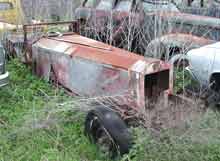Wayne Graefen spotted this long-nose beastie while combing the Texas scrapyards (it’s an honourable profession – somebody’s got to do it). Doubly intriguing is what seems to be the
anchor for a sidemount spare. Wayne describes the machine as a hot rod, but what to make of that long hood? He muses “how great it would be if I could only find one of the inline 12-cylinders that my father-in-law insists he saw as a young man.” Inline 12? Was there such a thing?
Inline engines are pervasive. Amost from the beginning there were inlines, in two, three, four, then six cylinders. By 1915, Hudson was touting itself as the “world’s largest manufacturer of six-cylinder cars.” In 1917, Hudson introduced the
Super Six, featuring a counterbalanced crankshaft for unprecedented smoothness. The inline, or straight, eight didn’t arrive until a few years later.
Eights in a vee configuration were common – Rolls-Royce built a few from 1904 to 1906, and by 1917 they were ubiquitous in the New World from such makers as Apperson, Cole, Cadillac, even
Chevrolet. It was 1920, however, before the straight eight took hold, in Italy (Isotta-Fraschini), Belgium
(Miesse) and Britain (Leyland). America’s first production straight eight was the
Duesenberg Model A, introduced for 1922.
Straight eights have some built-in complications. Their long crankshafts are subject to flexing, which can result in fracture. Remedies include stengthening the crank (adding weight) or additional main bearings (adding friction – even a lubricated bearing has more resistance than no bearing at all). Packard made a major advance in 1924 with a symmetrical crankshaft that corrected the imbalance of earlier stright eights, making one of the smoothest engines of that time.
By 1930, virtually all American automakers featured straight eights, starting just above the low-priced range with Dodge, DeSoto and Pontiac. Hudson stretched the small Essex six to eight pots that year, and made it available in the low-priced
Terraplane in 1933. A splash-lubricated engine, its derivatives were offered until 1952. Packard’s
Super Eight engine featured nine mains, and Buick’s Valve-in-Head
“Fireball” attacked the eight’s other Achilles heel, uneven fuel distribution, with Compound Carburetion in 1941. Thirsty and somewhat difficult to tune, Compound Carburetion was not universally revered. The last American straight eights, Packard and
Pontiac, gave up after 1954, though some European manufacturers briefly soldiered on.
But what about the inline twelve? Yes, Wayne, there was a straight twelve. For that we can thank
Gabriel Voisin, the idiosyncratic French aviation engineer who also built automobiles. Voisin’s cars were as eccentric as he was, the
Aérodyne C25 being a case in point. In contrast to the car’s slippery shape, Voisin added some
external braces to strengthen the front fenders, and topped it off with his characteristic laminated aluminum
bird mascot. Most Voisins were sixes, but a few V-12s were built from 1929 to 1931. In 1934, Voisin began experimenting with a straight twelve, made by coupling two 3-liter sixes nose-to-tail. His intent was to improve weight distribution, and to this end the engine extended far back into the passenger space. Two such cars were built, Voisin’s own, an
Aérosport Coupe, and one sedan. Production never materialized. Does anyone have a photo of the straight twelve engine?
The CarPort is grateful to Bud Gardner and his Encyclopedia of Eights for much of the knowledge in this installment. The Encyclopedia is a handy reference covering the basics of all the world’s eight-cylinder automobile engines and will be published in electronic format later this summer. Contact Bud for pricing and ordering info.

